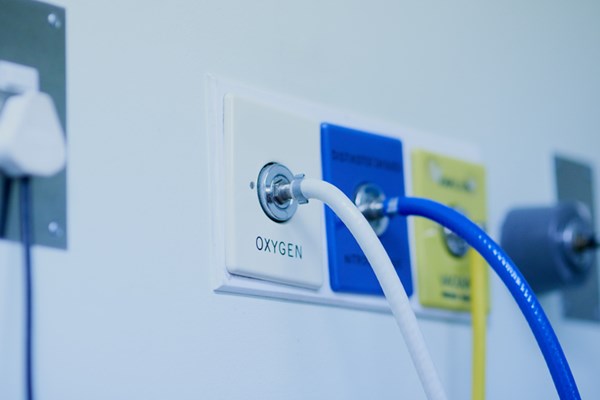Article
Schjorring OL, Klitgaard TL, Perner A, et al. Lower or Higher Oxygenation Targets for Acute Hypoxemic Respiratory Failure. N Engl J Med. January 2021. Doi: 10.1056/NEJMoa2032510. Online head of print.
OBJECTIVE
Authors hypothesized that treating patients admitted to the ICU with acute hypoxemic respiratory failure to a target PaO2 of 60 mmHg would reduce 90-day mortality by 5 percentage points compared to treating to a target PaO2 of 90 mmHg
BACKGROUND
Patients treated in the ICU for acute hypoxemic respiratory failure frequently require supplemental oxygen through an open (ie, masks such as the non-rebreather, simple, or venturi; high-flow nasal cannula, etc.) or closed delivery system (mechanical ventilation). Supplemental oxygen and the associated treatment target remains a delicate balance of preventing hypoxia-induced ischemic injury while avoiding hyperoxia driven reactive oxygen species injury or in COPD patients, inhibiting the respiratory drive. The ideal oxygenation goal in patients with acute respiratory failure in the ICU remains unclear. Different publications have produced conflicting data regarding potential risks and benefits with use of high levels of supplemental oxygen in patients with acute respiratory failure. Since 2018, one systematic review concluded higher oxygenation goals resulted in increased mortality in acutely ill patients, while a separate trial in 2020 revealed lower oxygenation resulted in increased mortality and secondary adverse events. (1-2) The authors of the Handling Oxygenation Targets in the ICU (HOT-ICU) trial aimed to discern if 90-day mortality differed between ICU patients with acute hypoxemic respiratory failure when treated to a goal PaO2 of 60 or 90 mmHg.
DESIGN
- Multi-center, stratified, parallel-group randomized control trial
SELECTION AND INCLUSION CRITERIA
- Patients age 18 or older within 12 hours of admission to the ICU with acute hypoxemic respiratory failure
- Must be receiving at least 10 L O2 per minute in open system or FiO2 of at least 0.5 in closed system
- Expected to receive supplemental O2 for at least 24 hours in the ICU
- Arterial line must be in place
**Full exclusion criteria can be found in the supplementary appendix available here**
OUTCOMES
Primary
- All-cause mortality within 90 days after randomization
Secondary
- One or more serious adverse events (myocardial ischemia, new episode of shock, cerebral ischemia, or intestinal ischemia)
- Percentage of days patients lived without life support (absence of mechanical ventilation, renal-replacement, or vasopressor/inotrope infusion)
- Percentage of days patients were alive at 90-day follow-up after hospital discharge
KEY RESULTS
Primary Outcomes
- No significant effect on 90-day mortality between the lower-oxygenation and higher-oxygenation groups. 618 of 1441 patients (42.9%) in the lower-oxygenation group died compared to 613 of 1447 patients (42.4%) in the higher-oxygenation group (RR, 1.02; 95% CI 0.94-1.11; P-0.64)
Secondary Outcomes
- No significant difference in percentage of patients alive without life support after 90 days
- No significant difference after 90 days in percentage of days alive after discharge
- No significant difference in the number of patients who suffered one or more serious adverse events
STRENGTHS
- Multi-center randomized control trial with moderate sample size
- Use of mechanical ventilation, prone positioning, inhaled vasodilators, ECMO, circulatory support, renal-replacement therapy, and blood transfusions similar amongst both groups, reducing the potential for confounding variables
- Maintained difference in PaO2, SaO2, and FiO2 levels between the two treatment groups to allow between-group difference analysis on outcomes
- Minimal missing data points (less than 5% for all outcomes)
LIMITATIONS
- Sample size not sufficient to definitively preclude harm or benefit of lower oxygenation targets
- Post hoc assessment revealed possible differences in treatment effects among different ICUs
- High mortality rate due to degree of severity of hypoxemia in this patient sample compared to prior studies
- Results may not be generalizable to patients with acute brain injury or neurologic illness due to increased sensitivity to PaO2, SaO2, and PCO2.
- Varying sample schedules for PaO2 among patients due to logistical challenge of obtaining point-of-care arterial blood gases
EM TAKE-AWAYS
This randomized control trial demonstrated treating ICU patients with acute hypoxemic respiratory failure with supplemental oxygen to a target PaO2 of 60 or 90 mmHg resulted in no significant difference in 90-day mortality, severe adverse events, or percentage of days without life support after 90 days.
When treating patients in acute respiratory failure, it is important to consider that oxygen exchange in the lungs is largely perfusion-limited, and reversing such causes of respiratory failure should be the primary goal of care prior to aggressive titration of supplemental oxygen that may ultimately not change the ventilation/perfusion mismatch.
While the results obtained in the HOT-ICU trial do not illustrate a clearly superior oxygenation goal in patients with acute respiratory failure, it does indicate treating to a high PaO2 goal may not be necessary to reduce mortality.
References
- Chu DK, Kim LH-Y, Young PJ, et al. Mortality and morbidity in acutely ill adults treated with liberal versus conservative oxygen therapy (IOTA): a systematic review and meta-analysis. Lancet. 2018;391(10131):1693-1705.
- Barrot L, Asfar P, Mauny F, et al. Liberal or Conservative Oxygen Therapy for Acute Respiratory Distress Syndrome. N Engl J Med. 2020;382(11):999-1008.




